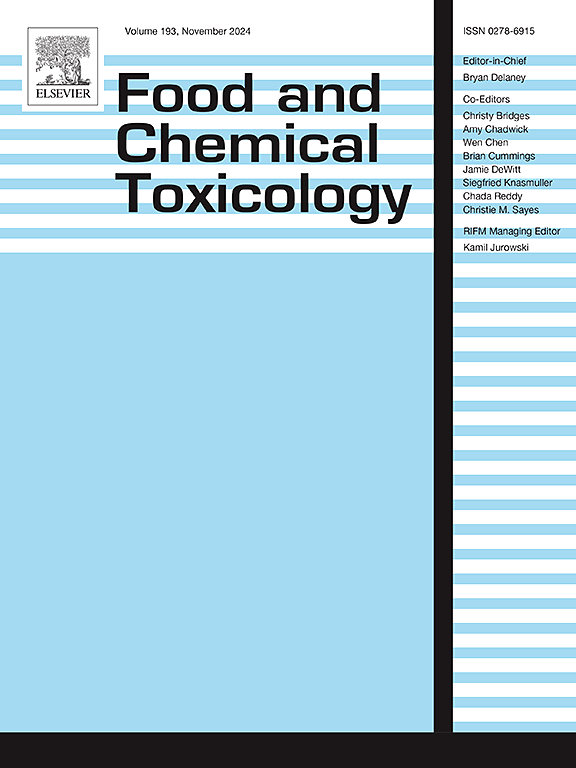Investigation of the effects of morin on potassium bromate-induced brain damage in rats via different pathways with biochemical and histopathological methods
IF 3.9
3区 医学
Q2 FOOD SCIENCE & TECHNOLOGY
引用次数: 0
Abstract
Aim
Potassium bromate (KBrO3) is a colorless, odorless substance used as a food additive. It causes multiple organ damage and neurotoxicity. Morin is a flavonoid from the Moraceae family known to have anti-inflammatory, antioxidant, antiapoptotic, antiautophagic, and neuroprotective properties. Therefore, this study aimed to investigate the effects of Morin against KBrO3-induced brain damage.
Methods
62 mg/kg KBrO3 and 50–100 mg/kg Morin were administered to 35 male rats by oral gavage daily for 14 days. Various analyses were performed using molecular, biochemical, and histological methods.
Results
The analyses results showed that KBrO3 application decreased antioxidant markers and raised lipid peroxidation in the brain tissue. The KBrO3 application triggered apoptosis, endoplasmic reticulum stress, and inflammation. Morin treatment increased enzymatic and nonenzymatic antioxidant levels and decreased lipid peroxidation. In addition, Morin alleviated KBrO3-induced apoptosis, endoplasmic reticulum stress, and inflammation in the brain tissue. The histopathological analysis revealed an increase in degenerative changes, as well as pyknotic changes and vacuolization in cells, in neurons in the KBrO3 group. Increased hyperemia and congestion were detected in the meninges and vessels in the cerebral cortex.
Conclusion
KBrO3 application caused toxicity in the brain tissue and impaired tissue integrity, whereas Morin treatment alleviated KBrO3-induced toxicity.
采用生物化学和组织病理学方法探讨桑辣素对溴酸钾致大鼠脑损伤的影响
溴酸钾(KBrO3)是一种无色无味的食品添加剂。它会造成多器官损伤和神经毒性。桑辣素是一种来自桑科的类黄酮,具有抗炎、抗氧化、抗细胞凋亡、抗自噬和神经保护作用。因此,本研究旨在探讨桑辣素对kbro3诱导的脑损伤的作用。方法雄性大鼠35只,每天灌胃给予KBrO3 62 mg/kg、Morin 50 ~ 100 mg/kg,连续灌胃14 d。使用分子、生化和组织学方法进行各种分析。结果应用KBrO3可降低脑组织抗氧化标志物,提高脑组织脂质过氧化水平。KBrO3的应用引发细胞凋亡、内质网应激和炎症。马桑素处理增加酶促和非酶促抗氧化水平,降低脂质过氧化。此外,Morin还能减轻kbro3诱导的脑组织凋亡、内质网应激和炎症。组织病理学分析显示,KBrO3组神经元的退行性变化、细胞固缩变化和空泡化增加。脑膜和大脑皮层血管充血和充血增加。结论kbro3对大鼠脑组织有毒性作用,脑组织完整性受损,Morin可减轻kbro3对大鼠脑组织的毒性作用。
本文章由计算机程序翻译,如有差异,请以英文原文为准。
求助全文
约1分钟内获得全文
求助全文
来源期刊

Food and Chemical Toxicology
工程技术-毒理学
CiteScore
10.90
自引率
4.70%
发文量
651
审稿时长
31 days
期刊介绍:
Food and Chemical Toxicology (FCT), an internationally renowned journal, that publishes original research articles and reviews on toxic effects, in animals and humans, of natural or synthetic chemicals occurring in the human environment with particular emphasis on food, drugs, and chemicals, including agricultural and industrial safety, and consumer product safety. Areas such as safety evaluation of novel foods and ingredients, biotechnologically-derived products, and nanomaterials are included in the scope of the journal. FCT also encourages submission of papers on inter-relationships between nutrition and toxicology and on in vitro techniques, particularly those fostering the 3 Rs.
The principal aim of the journal is to publish high impact, scholarly work and to serve as a multidisciplinary forum for research in toxicology. Papers submitted will be judged on the basis of scientific originality and contribution to the field, quality and subject matter. Studies should address at least one of the following:
-Adverse physiological/biochemical, or pathological changes induced by specific defined substances
-New techniques for assessing potential toxicity, including molecular biology
-Mechanisms underlying toxic phenomena
-Toxicological examinations of specific chemicals or consumer products, both those showing adverse effects and those demonstrating safety, that meet current standards of scientific acceptability.
Authors must clearly and briefly identify what novel toxic effect (s) or toxic mechanism (s) of the chemical are being reported and what their significance is in the abstract. Furthermore, sufficient doses should be included in order to provide information on NOAEL/LOAEL values.
 求助内容:
求助内容: 应助结果提醒方式:
应助结果提醒方式:


